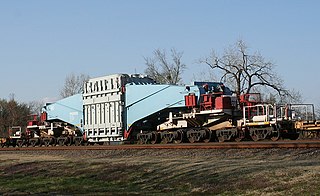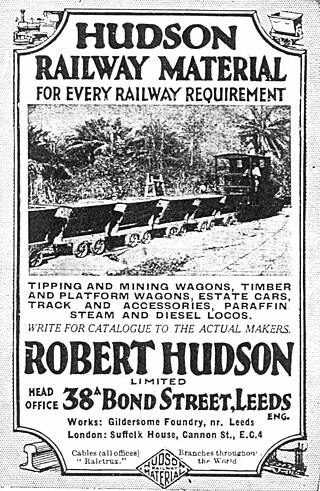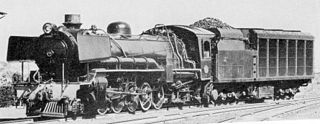Related Research Articles

A bogie is a chassis or framework that carries a wheelset, attached to a vehicle—a modular subassembly of wheels and axles. Bogies take various forms in various modes of transport. A bogie may remain normally attached or be quickly detachable. It may include a suspension component within it, or be solid and in turn be suspended ; it may be mounted on a swivel, as traditionally on a railway carriage or locomotive, additionally jointed and sprung, or held in place by other means.

A semi-trailer truck, is the combination of a tractor unit and one or more semi-trailers to carry freight. A semi-trailer attaches to the tractor with a type of hitch called a fifth wheel.

A truck or lorry is a motor vehicle designed to transport freight, carry specialized payloads, or perform other utilitarian work. Trucks vary greatly in size, power, and configuration, but the vast majority feature body-on-frame construction, with a cabin that is independent of the payload portion of the vehicle. Smaller varieties may be mechanically similar to some automobiles. Commercial trucks can be very large and powerful and may be configured to be mounted with specialized equipment, such as in the case of refuse trucks, fire trucks, concrete mixers, and suction excavators. In American English, a commercial vehicle without a trailer or other articulation is formally a "straight truck" while one designed specifically to pull a trailer is not a truck but a "tractor".

Wagonways, also known as horse-drawn railways and horse-drawn railroad consisted of the horses, equipment and tracks used for hauling wagons, which preceded steam-powered railways. The terms plateway, tramway, dramway, were used. The advantage of wagonways was that far bigger loads could be transported with the same power.

An axle or axletree is a central shaft for a rotating wheel or gear. On wheeled vehicles, the axle may be fixed to the wheels, rotating with them, or fixed to the vehicle, with the wheels rotating around the axle. In the former case, bearings or bushings are provided at the mounting points where the axle is supported. In the latter case, a bearing or bushing sits inside a central hole in the wheel to allow the wheel or gear to rotate around the axle. Sometimes, especially on bicycles, the latter type of axle is referred to as a spindle.

The railway track or permanent way is the elements of railway lines: generally the pairs of rails typically laid on the sleepers or ties embedded in ballast, intended to carry the ordinary trains of a railway. It is described as a permanent way because, in the earlier days of railway construction, contractors often laid a temporary track to transport spoil and materials about the site; when this work was substantially completed, the temporary track was taken up and the permanent way installed.

In both road and rail vehicles, the wheelbase is the horizontal distance between the centers of the front and rear wheels. For road vehicles with more than two axles, the wheelbase is the distance between the steering (front) axle and the centerpoint of the driving axle group. In the case of a tri-axle truck, the wheelbase would be the distance between the steering axle and a point midway between the two rear axles.

Under the Whyte notation for the classification of steam locomotives, 4-2-0 represents the wheel arrangement of four leading wheels on two axles, two powered driving wheels on one axle and no trailing wheels. This type of locomotive is often called a Jervis type, the name of the original designer.

Rolling resistance, sometimes called rolling friction or rolling drag, is the force resisting the motion when a body rolls on a surface. It is mainly caused by non-elastic effects; that is, not all the energy needed for deformation of the wheel, roadbed, etc., is recovered when the pressure is removed. Two forms of this are hysteresis losses, and permanent (plastic) deformation of the object or the surface. Note that the slippage between the wheel and the surface also results in energy dissipation. Although some researchers have included this term in rolling resistance, some suggest that this dissipation term should be treated separately from rolling resistance because it is due to the applied torque to the wheel and the resultant slip between the wheel and ground, which is called slip loss or slip resistance. In addition, only the so-called slip resistance involves friction, therefore the name "rolling friction" is to an extent a misnomer.

A Schnabel car or Schnabel wagon is a specialized type of railroad freight car. It is designed to carry heavy and oversized loads in such a way that the load makes up part of the car. The load is suspended between the two ends of the cars by lifting arms; the lifting arms are connected to an assembly of span bolsters that distribute the weight of the load and the lifting arm over many wheels.

The North Coast railway line (NCL) is a 1,681-kilometre (1,045 mi) 1067 mm gauge railway line in Queensland, Australia. It commences at Roma Street station, Brisbane, and largely parallels the Queensland coast to Cairns in Far North Queensland. The line is electrified between Brisbane and Rockhampton. Along the way, the 1680 km railway passes through the numerous towns and cities of eastern Queensland including Nambour, Bundaberg, Gladstone, Rockhampton, Mackay and Townsville. The line though the centre of Rockhampton runs down the middle of Denison Street.
The African Union of Railways is an organisation under the auspices of the new African Union dealing with railways. It is similar to the International Union of Railways (UIC).

Route Availability (RA) is the system by which the permanent way and supporting works of the railway network of Great Britain are graded. All routes are allocated an RA number between 1 and 10.

A truck scale (US), weighbridge (non-US) or railroad scale is a large set of scales, usually mounted permanently on a concrete foundation, that is used to weigh entire rail or road vehicles and their contents. By weighing the vehicle both empty and when loaded, the load carried by the vehicle can be calculated.

In road transport, an oversize load is a load that exceeds the standard or ordinary legal size and/or weight limits for a truck to convey on a specified portion of road, highway, or other transport infrastructure, such as air freight or water freight. In Europe, it may be referred to as special transport or heavy and oversized transportation. There may also be load-per-axle limits. However, a load that exceeds the per-axle limits but not the overall weight limits is considered overweight. Examples of oversize/overweight loads include construction machines, pre-built homes, containers, and construction elements.

Robert Hudson Ltd was a major international supplier of light railway materials, based in Gildersome, near Leeds, England. The name was later changed to Robert Hudson (Raletrux) Ltd.

The South African Railways Class 21 2-10-4 of 1937 was a class of steam locomotives used in South Africa.

The South African Railways Class 20 2-10-2 of 1935 was a steam locomotive.

A jeep train usually refers to a line of coupled railway vehicles hauled by a jeep fitted with railway wagon wheels instead of normal road wheels. World War II jeeps were converted from road vehicles into steel-wheeled rail switchers, shunters, light locomotives, speeders or draisines. The phrase was also used for supply trains consisting of jeeps and for columns of jeeps linked together and pulled through bad ground by tractors. Not all primary sources will use this phrase in the same way. Colloquially, the term jeepomotive has been used on several occasions.

The South African Railways Dutton road-rail tractors of 1923 were road-rail steam tractors.
References
- ↑ "Fortescue opens the world's heaviest haul railway". Railway Gazette. 2008-07-14. Archived from the original on 2016-02-22. Retrieved 2016-02-18.
- ↑ Peter Ker (2011-10-24). "Fortescue takes another step in plan to boost Pilbara railway loads". The Sydney Morning Herald. Archived from the original on 2018-05-11. Retrieved 2012-08-06.
- ↑ FMG Axle load
- ↑ Hjort, Mattias; Haraldsson, Mattias; Jansen, Jan (2008). "Road Wear from Heavy Vehicles: An Overview" (PDF). NVF committee Vehicles and Transports. p. 17+36. ISSN 0347-2485. Archived from the original on 2016-08-18.